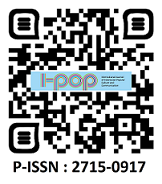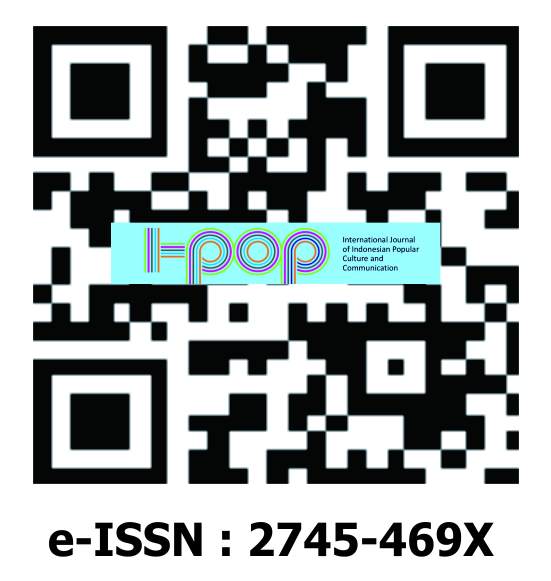Tante Lala's Comedy
Representation of Symbolic Annihilation on Women in Media
Abstract
Tante Lala's comedy is a video depicting a mother who had difficulties while accompanying her child to study during the Covid-19 pandemic. The video shows the character of a mother who is impatient, angry, and even fails to educate her child. Unfortunately, the video went viral on social media and was even made viral by an infotainment program on TV and some media. This paper aims to reveal how the symbolic annihilation of women is practiced and reproduced and how the media presents stereotypes of women as a spectacle. This paper will also explore how female viewers perceive Tante Lala's video content. The research uses a cultural studies approach and critical discourse analysis as the method. The result shows that symbolic annihilation in Tante Lala's Video was represented by various texts, visual images, and text flow. Within 10:6 minutes, various texts' connotations of a woman character are found, contributing to women's symbolic annihilation. Visually, the camera focuses on the face depicting a fierce and bitchy character. Second, symbolic annihilation is represented in the form of media affirmation of the video through news and infotainment. In addition to the form of affirmation, the media also explicitly uses language that discriminates against women's characters. Informants assessed that the content of Tante Lala's video and media reports and infotainment broadcasts related to the video gave a wrong depiction of women. They argue that the media is also considered to have contributed to stereotyping women based on emotion rather than rationality.
Downloads
References
Buikema, R., (2017). The Arena of Imaginings: Sarah Bartmann and the Ethics of Representation. In R. Bulkema, L. Plate, & K. Thiele (eds), Doing Gender in Media, Art and Culture: A Comprehensive Guide to Gender Studies (2nd ed.). Routledge
Durham, M. G., & Kellner, D. M. (2012). Media and cultural studies: Keyworks (2nd ed.). Wiley
Flicker, E. (2003,). Between brains and breasts—women scientists in fiction film: on the marginalization and sexualization of scientific competence. Public Understanding of Science, 12(3), 307-318. https://doi.org/10.1177%2F0963662503123009
Friedan, B. (1963). The Feminine Mystique. Penguin Books.
Guba, E. G., & Lincoln, Y. S. (1994). Competing paradigms in qualitative research. In N. K. Denzin & Y. S. Lincoln (Eds.), Handbook of qualitative research (pp. 105–117). Sage Publications, Inc.
Hall, S. (1997). Introduction & The Work of Representation. In S. Hall (ed), Representation: Cultural Representations and Signifying Practices. Sage
Hall, S. (2003). The Work of Representation, in Stuart Hall (ed.). Representation, 13-74. Sage.
Haraldsson, A., & Wängnerud, L. (2019). The effect of media sexism on women’s political ambition: evidence from a worldwide study. Feminist Media Studies, 19(4). https://doi.org/10.1080/14680777.2018.1468797
Harcis, A. P. (2020, October 6). Momen Viral Gegara Pancasila Bikin Tante Lala Panik, Lo Kenapa? [The Viral Moment of Pancasila Causes Aunt Lala to Panic, Why?]. Insert Live. https://www.insertlive.com/hot-gossip/20201006174616-7-165656/momen-viral-gegara-pancasila-bikin-tante-lala-panik-lo-kenapa
Hu, S., X. (2020). Toxic royalty: feminism and the rhetoric of beauty in disney princess films. Inquiries Journal of Social Science, Art, and Humanities 12(7). http://www.inquiriesjournal.com/articles/1788/toxic-royalty-feminism-and-the-rhetoric-of-beauty-in-disney-princess-films
Jackson, S. and Jones, J. (2009). Pengantar Feminis Kontemporer. Jalasutra.
Jhally, S. (2005). Stuart Hall: Represenatation and the Media (transcript). Media Education Foundation.
Mallam, S., K., R. (2019). Sexual harassment as courtship: Performing Hegemonic Masculinity in Contemporary Telugu Cinema. Journal of Creative Communications, 14(2), 118–131. https://doi.org/10.1177%2F0973258619848626.
Mills, S. (2008). Language and sexism. Cambridge University Press.
Noviani, R., 2020, Politik Representasi di Era Serbamedia, in Wening Udasmoro. Gerak Kuasa: Politik Wacana, Identitas, dan Ruang/Waktu dalam Bingkai Kajian Budaya dan Media. Jakarta: Gramedia,pp. 59-84.
Priatmojo, D. (2020, October 4). Sosok Tante Lala, Emak Viral yang Ngegas Ajarkan Anak Pancasila. [The figure of Aunt Lala, the Viral Mother Who Hastens to Teach Children the Pancasila]. Viva. https://www.viva.co.id/trending/1308538-sosok-tante-lala-emak-viral-yang-ngegas-ajarkan-anak-pancasila?page=3&utm_medium=page-3
Miles, M. B., Huberman, A. M., & Saldana, J. (2019). Qualitative data analysis. A methods sourcebook. Sage
Sassatelli, R. (2011). Interview with Laura Mulvey: Gender, Gaze and Technology in Film Culture. Theory, Culture & Society, 28(5). 123-145. https://doi.org/10.1177/0263276411398278
Saukko, P. (2011). Doing Research in Cultural Studies: An introduction to classical and new methodological approaches (Online ed.). Sage. https://dx.doi.org/10.4135/9781849209021
Schulz, J. L. dan Youn, J. (2020). Monsters and Madwomen? Neurosis, Ambition and Mothering in Women Lawyers in Film. Journal of Law, Culture and the Humanities, 16(3), 411–431.
Sumita, S. (2014). Media and women image: A Feminist discourse. Journal of Media and Communication Studies, 6(3). https://doi.org/10.5897/jmcs2014.0384
Suryakusuma, J. (2011). State Ibuism the Social Construction of Womanhood in New Order Indonesia. Komunitas Bambu
SuryaTV (2020, October 2). Lucu, Tante Lala Ajari Anak Baca Pancasila sampai Darah Tinggi [Funny, Aunt Lala teaches her child to read Pancasila until she suffers from hypertension]. Youtube. https://www.youtube.com/watch?v=HEm6wmHzc90
Syamsuddin, S. (2020, September 21). Bocah 10 Tahun Dianiaya dengan Balok Kayu gara-gara Tak Ikut Belajar online, Ibu Kandung: Saya Menyesal. [10-Year-Old Boy Abused with Wooden Blocks for Not Participating in Online Learning, Biological Mother: I Regret]. Kompas. https://regional.kompas.com/read/2020/09/21/05340061/bocah-10-tahun-dianiaya-dengan-balok-kayu-gara-gara-tak-ikut-belajar-online?page=all
Tuchman, G. (2000). The Symbolic Annihilation of Women by the Mass Media. In Culture and Politics. https://doi.org/10.1007/978-1-349-62965-7_9
van Dijk, T., A. (2015). Critical discourse analysis, in Deborah Tannen, Heidi E. Hamilton, & Deborah Schiffin (2nd ed). The Handbook of Discourse Analysis. Blackwell.
Woodward, K. (1999). Identity and Difference: Cultural, Media and Identities. Sage
Copyright (c) 2021 I-Pop: International Journal of Indonesian Popular Culture and Communication

This work is licensed under a Creative Commons Attribution-NonCommercial-ShareAlike 4.0 International License.











